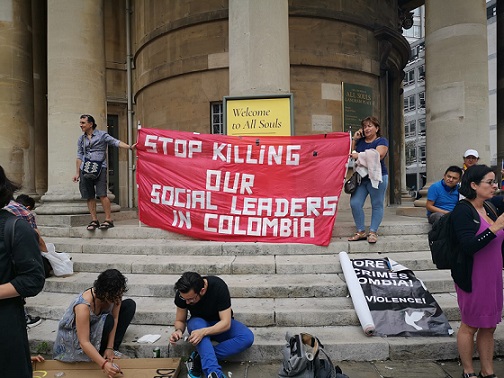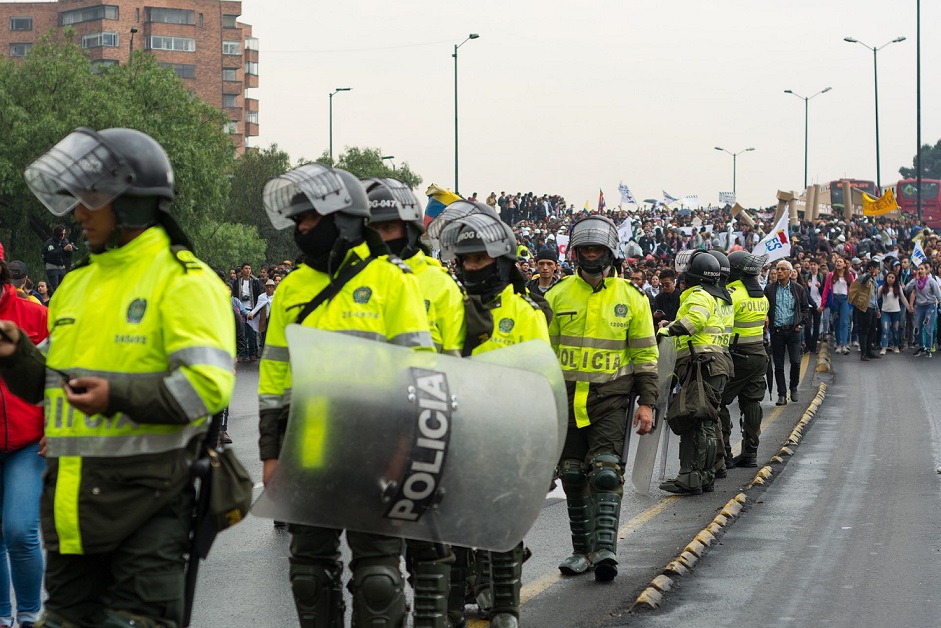On the 5th March 2009, the ex-paramilitary commander of United Self-Defence Unit of Colombia (AUC in Spanish), José Éver Veloza, alias H.H, was extradited to the US in order to account for his dealings in narco-trafficking crimes. The Prisma’s Memoirs. April 2011.

Up until the day before H.H’s extradition, the director and producer Juan José Lozano, who resides in Switzerland, and the renowned journalist Hollman Morris, had agreed to have the final interview with the ex-chief of the Bloque Bananero and Bloque Calima, both factions of the AUC. By that point however, the ex-paramilitary’s extradition was imminent.
The planned interview was going to be part of the documentary “Impunity”, showed in London on 29th March just gone, in the Human Rights Watch Film Festival. But the meeting with Éver Veloza never came about.
H.H is one of the paramilitary bosses who has confessed to committing the most crimes during the Justicia y Paz (Justice and Peace) process that started in 2005, with the aim of redressing victims of massacres, displacements and forced disappearances due to paramilitarism that plague Colombians for 30 years, above all in the countryside.
In H.H’s version of events, he has pointed out existing links between the AUC and important Colombian business and political figures as well as the Church and the Colombian Army. It is calculated that with his extradition, crimes recorded by the Public Prosecotor’s Office still remain to be solved.
It is precisely his being forced to flee, an act supported and favoured by the government of the ex-president Álvaro Uribe Vélez, that is silencing one of the people most involved in rubbing salt in the wound with regards to high profile figures in Colombia and their links with the paramilitary. H.H was the main focus for Lozano and Morris’ documentary “Impunity”, a film that analyses the way in which the Justicia y Paz process has unfolded, using the case of the ex-paramilitary as a basis.
According to the theory maintained by Lozano and Morris in the documentary, the aforementioned process was a failure, an illusion when all is said and done, promoted by the Colombian government. In this sense, Hollman points out that “35% of the Congress of the Nation was bribed by the paramilitaries and part of that Congress made the first draft of the Justice and Peace Law. That is to say, they themselves were creating their own law to grant themselves amnesty”.
 The Colombian government estimated that since 2003 there were more than 30,000 paramilitaries demobilized and around 20,000 arms were handed in, but in the large majority of cases only the most obvious leaders of the paramilitary groups accepted the conditions of the process.
The Colombian government estimated that since 2003 there were more than 30,000 paramilitaries demobilized and around 20,000 arms were handed in, but in the large majority of cases only the most obvious leaders of the paramilitary groups accepted the conditions of the process.
Some soon returned to paramilitary activity and those that did not rearm left behind arms and people capable of carrying on with these crimes. Furthermore, the main demobilised paramilitary chiefs, like Salvatore Mancuso or “Don Berna” were progressively extradited to the US to account for their dealings in narco-trafficking, the same as H.H, whose case is more recent.
Pressure and threats
Lozano and Hollman filmed the Justice and Peace process accompanying the victims during the exhumation of cadavers and public hearings of paramilitary chiefs giving their accounts; which the relatives of the victims attended. But the work on the documentary was interrupted in February of 2009 and much of the filming could not be used.
“There was pressure and a certain number of death threats that obliged us to stop the project”, said Lozano. The first of which he received in his house in Switzerland; it was a letter which made references to the documentary and which made death threats against the director and producer.
The second arrived just a day before the agreed interview with H.H. In Lozano’s words, “the work process was interrupted for three months after the second threat. We found ourselves not knowing how to re-shoot the film because the interview with H.H was crucial and it was then when we delved into the files and began to collect information from other sources and re-write the film”.
In total, Lozano and Hollman accumulated 620 hours’ worth of footage from the files lent to them by an association of victims, lawyers and civil servants of the Attorney General of Colombia as well as his own recordings from his work on Contravía, a television project started by Morris in 2003 about the armed conflict in Colombia.
With regards to the frustrated interview with H.H, or lack thereof, Hollman points out that they had managed to build up “confidence, for want of a better word, with Veloza when he himself already saw that he was going to extradited”.
“He promised to tell us a lot in this meeting, but it could not be in the end”, he adds.
“Looking at it with hindsight we could have said: let’s go for it and interview him, but we took advice on the issue and they assured us that it was already the second death threat and that if we went ahead with the interview the risk was very high”, Lozano indicates.
The pressure did not stop there. The problems increased, they assure, when Hollman had access to a file that the secret police had put together with photos of his children, transcriptions of telephone conversations and emails.
“The coordination and the work are screwed when you know that they are spying on you, because like that it’s very difficult to share information”, Lozano points out.
He adds to what was previously said about the accusation of collaborating with the guerrillas that the ex-president Uribe blamed Hollman for in 2009 because of his journalistic work.
“My life stopped there”, the Colombian journalist assured. The secret service knew every step we were taking and the issue concerning the film. Their strategy was, according to my hypothesis, to attack and boycott everything that could be critical towards the Uribe administration”, says Hollman.

Between self-censorship and independence
To all this, must be added ex-president Uribe’s accusation in February 2009 against Morris, of collaborating with the guerrillas through his journalistic work. “My life ended there”, affirms the Colombian journalist. “The secret service knew every step we were taking and all about the subject of the film. Their strategy was, from my point of view, to attack and boycott everything that could have been deemed critical of the Uribe administration”, says Morris.
A career in journalism, as much for Lozano as for Morris, is not an easy one in Colombia, due in part to the information the journalists themselves subject their own. According to Morris one of the solutions to this problem would consist in the joining together of all those alternative media into one great conglomerate that drew together all the independent press to have “a real and definite impact on public opinion”. “I see enormous and honourable efforts from small communication groups, but at the end of the day, the impact their media has affects only them, in other words, it is like the tribe telling only itself the tale; however, the tribe has to speak out to the world and we have not been able to achieve that”, Morris remarks.
A piece of the puzzle
In spite of the initial project being pulled, the directors made the story to try and remember the victims and pay them homage. “With this film we do not report anything that is not known, the facts are there – Lozano says-. We try to build up a memory and add another piece to the puzzle that has been, and carries on being the history of violence in Colombia”.
For his part, Hollman declares that the idea behind of “Impunity” was to try to show “five years of history that went over our heads that this country does not know”. He says it making reference to the victims of paramilitary regimes during the Justice and Peace process. The sacrifices people made, putting up with the heat and the hunger, to get to the hearings, were not shown. Everything was not talked about apart from those sacrifices so it finished by completely blurring the image of the victims”. To this he adds that Colombia “fortunately has documented the barbarianism and the tragedy of guerrilla warfare.

However, it has not been like that with the barbarities of the paramilitaries, a tragedy that still has not ended”.
“From my hopeful point of view I believe that this documentary will be useful if it gets the attention of a society that up to now has not wanted to see certain things; it puts the focus on the Justice and Peace process and looks towards correction. As for the rest, it is a historical documentary and one that pays respect to the victims”, Hollman concludes.
(Translated by Piers Jarvis – Email: piersjarvis@hotmail.com)
(Photos: Pixabay)












.jpg)












